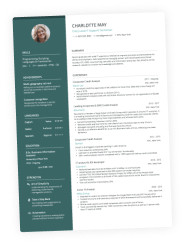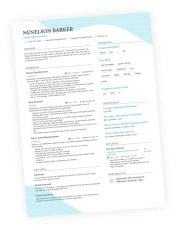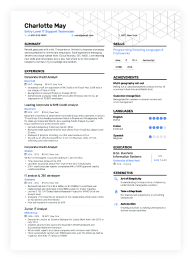You’ve perfected your experience section, polished off your skills, and crafted a compelling summary. Go you! But have you overlooked the basics? Personal details might seem like an afterthought, but getting them wrong or overdoing it can damage your reputation.
From outdated full addresses to eyebrow-raising email handles, there are plenty of pitfalls to avoid. Yes, there’s an art to knowing what personal details to put on a CV.
In this guide, we’ll walk you through exactly what to include (and what to leave out), plus how to format it like a pro.

Key takeaways
- Your personal details should be concise, professional, and placed at the top.
- Only include essentials like your full name, phone number, email, location, and relevant links (e.g. LinkedIn or portfolio).
- Avoid adding sensitive details like your date of birth, marital status, or full address—they’re outdated and unnecessary.
- Keep your email address professional—no jokes, puns, or nicknames that could undermine your credibility.
- Use clean formatting and keep your header ATS-friendly by making it clear, consistent, and logically organised.
Is your CV hitting the mark? Upload it now and find out:
Is your CV good enough?
Drop your CV here or choose a file. PDF & DOCX only. Max 2MB file size.
First up, let’s start with a quick definition.
What are personal details on a CV?
Personal details are simply the basic information you should include on your CV, such as your full name, contact details, and location. These are essential as they mean the hiring manager can quickly and easily get in touch with you. Your personal details are usually placed at the very top of your CV, either in a header or clearly laid out beneath your name.
Of course, there are extra details you might consider adding to your CV. It’s important to understand what information is relevant to the application process, and what is not.
While it’s a small section, it plays a critical role in allowing employers to contact you and quickly identify basic information relevant to the application process.
But it’s essential to keep this section focused. Too much personal data can be distracting—or worse, lead to unconscious bias.
Many applicants confuse personal details with contact details. While there’s overlap between the two, it pays to understand the difference before you get started.
Personal details vs. contact details
| Personal details | Contact details |
|---|---|
Basic information about you, plus your contact details. It includes the following:
| Your contact details are a part of your personal details. Usually, these are your:
|
So, why should you bother with this section? It’s not the thing that’s going to bag you the job. While your personal details may not show off your experience, they do tell the recruiter more than you might expect.

Why this section matters to UK recruiters
- Professionalism. Your CV header is one of the first things a hiring manager will look at. Making sure it’s clear and contains the right details shows you’re organised, detail-oriented, and serious about the role.
- Reachability. If your CV wows the hiring manager, they’ll want to reach out to you fast. Don’t make it hard for them. Position your contact details front and centre.
- Legality. Listing relevant personal details—and leaving out sensitive information—shows that you understand the legality of the hiring process well.
In the UK, hiring managers expect you to leave out certain personal details to support a fair and unbiased recruitment process. (Don’t worry—we’ll cover exactly what you should skip later on.)
However, it’s important to remember CV expectations vary widely across the world. For instance, while including a photo is common practice in many other countries, it’s generally discouraged in the UK. Understanding these regional differences is crucial when applying for roles internationally.
Personal details in the UK vs. other countries
| United Kingdom | Germany, France & Japan |
|---|---|
|
|
For now, let’s focus on what to include if you’re applying for jobs in Britain.
What personal details should you include in a UK CV?
Ready to put pen to paper? Knowing what personal details to put on a CV doesn’t have to be hard. However, there are rules that you’ll want to be aware of here.
Before we break each part down, let’s take a look at an example to whet your appetite:
This example is clear and concise, while also featuring all the main points. While it boasts the candidate’s LinkedIn URL, it could also include a portfolio or professional website if needed.
With Enhancv’s CV Builder, you can easily add an extra link—whether to a portfolio, professional website, or anything else that supports your application.
Now, let’s talk about why each element is vital.
Name
This one is a no-brainer. Your CV needs to include your first and last name right at the top. If you use a variation of your name professionally, you should add this in your header.

PRO TIP
Your name needs to stand out!
You want the hiring manager to remember your name—so don’t make it small. As a general rule, your name should be around 6 points larger than the rest of the information on your CV.
Looking to add a little pizazz to your name? You can always use a different font or colour to grab the reader’s attention. Just be sure it works with the rest of the CV design.
Next, list an email address—a small detail that can have a big impact.
Select a professional address, such as one that includes your first and last name. For example, “alex.smith@email.co.uk”.

PRO TIP
Leave out the “funny” email address.
Unless you’re applying to be a stand-up comedian, now’s not the time to be a joker. If your email address is funny or includes puns, you might want to make a new one.
The hiring manager will judge these minor details. A jokey handle can undermine your credibility and make hiring managers second-guess your professionalism before they’ve even seen your skills.
Phone number
Once you’ve dazzled the hiring manager with your CV, they’ll want to give you a call. Make it easy for them by putting a number you use regularly at the top of this document.
You can use either a home number or a mobile number. However, the latter may be better as it means the hiring manager will be able to reach you even when you’re out.
If you’re formatting this with the country code, add +44 first, and then delete the 0 at the start. Alternatively, for UK applications, you can leave the 0 in and write the number in full.
Best way to format a UK phone number on a CV
Mobile:
- 07700 900XXX (standard local format)
- +44 7700 900XXX (best when applying for jobs abroad or to multinational companies)
Landline (if relevant):
- 020 7946 00XX (London example)
- +44 20 7946 00XX (international format)
Location
Where are you located? While many jobs are now remote or hybrid, hiring managers still want to know where you’re based. In some cases—for hybrid or in-office setups—they will need to check you live within a commutable distance from the main site.
There’s no need to list your full postal address—it takes up space and adds no value at the early application stage. Instead, include your city and region only (e.g. “Manchester, UK”) or your postcode and town.
Thinking of upping sticks? Let the hiring manager know about it. If you’re open to moving for the right position, this could be a major selling point. Put “Willing to relocate” next to your location.
LinkedIn (optional)
Around 42.9 million Brits have LinkedIn profiles. That equals a whopping 61% of the population. If you’re part of that group, adding a hyperlink to your CV may be the way to go.
Before you do that, check that the details on your profile match your CV. Even the smallest of discrepancies can be real red flags for the hiring manager.
I definitely think it’s helpful to have your LinkedIn profile on your CV. However, it can help to reference it in the context of experience that you may be writing about.
For example, if you have a portfolio or a project specifically on LinkedIn, then you can link to that directly as a ‘see more about this here’ type of opportunity. Introducing it in this context could also then lead them to stay on your LinkedIn profile for longer.
Take your professionalism to a new level, and customise your LinkedIn URL. This takes less than five minutes to do and can help you to make the right impression on the hiring manager.
To format the URL on your CV, keep things simple. Take out the “http://www.” and add the rest of the address. You can then hyperlink the URL for a clean, clickable look.
Portfolio or website (optional)
If you work in the creative sector, you may have your own website or even an online portfolio. Including a link to this on your CV is a smart way to share your previous work with the hiring manager.
You don’t need to be a web developer to create a professional website or portfolio site. Here are some easy-to-use platforms you can try:
Experiment with one—or a few—of the above and see what you can make. When you’re happy with the results, list the URL or hyperlink in your CV header.
Cherrypick the best pieces of personal information for your CV. Whenever you’re thinking of adding something new, ask yourself why the hiring manager needs that detail. This approach helps you to avoid cramming your header with irrelevant details and keeps you solidly on track.
How to properly add your personal information on your CV
Now that you know what personal information belongs on your CV, let’s talk about where to put it. The best spot? Right at the top of the page in the header. Simple as that.

PRO TIP
There’s no need to get fancy here. This section should be clean, clear, and easy to scan. Think of it as your digital handshake. You don’t need to make the hiring manager dig for your details.
Check out the right and wrong ways to include personal details on your CV below:
Overcrowded headers vs. clean layout
White space is your best friend. When you’re listing personal details on your CV, you want to leave room around each piece of information. This makes the whole thing easier to read.
Here’s an example of a CV header with too much irrelevant information:
Overcrowded header
Julia Lopez
Date of Birth: 14/06/1991 | Nationality: British | Gender: Female | Marital Status: Single
Full Address: 17 Long Lane, Flat 2B, West London, W12 9XT, United Kingdom
Phone: +44 7712 34567XX | Email: julia.lopez@emaill.com
LinkedIn: linkedin.com/in/julialopez | Instagram: @julialopez_creative | Personal Blog: julialopezwrites.co.uk
The example above is difficult to digest and packed with unnecessary information. It’s unlikely to present the candidate in the best light and could even lead to unconscious bias issues.
Streamlining it is a must. Here’s how the same header might look with a clearer outline:
Good CV header
Julia Lopez
Marketing Strategist
London, UK
julia.lopez@email.com | +44 7712 3456XX
linkedin.com/in/julialopez
The second example is much clearer and only gives the hiring manager the information they need. Use this example as inspiration when writing your CV header.
Unprofessional email addresses vs. appropriate ones
Not all email addresses leave the right impression. As we mentioned earlier, it’s important to avoid quirky or humorous addresses. They can come across as unprofessional right from the start.
Unprofessional email address
Email: parttimewizard@hogwartsdropout.com
Unless you’re applying to work in a Harry Potter themed attraction, this email address won’t hit the mark. It reads as silly and unprofessional—traits that aren’t likely to impress the hiring manager.
If in doubt, stick to your first and last name (or your initials), like the example below:
Polished email address
Email: j.lopez@email.co.uk
You’re not trying to reinvent the wheel. Your professional email address needs to be clean and show the hiring manager that you take yourself seriously.
Relevant social media vs. irrelevant social media
To include social media or not to include social media? That is the question.
When deciding what personal details to put on a CV, many candidates stumble over this particular issue.
The answer is simple: You can add social profiles as long as they add value to your application. So, listing a professional Instagram (if you’re a photographer) or your LinkedIn page is acceptable.
However, linking to your private TikTok where you post skits is not. Use your best judgement here.
With that in mind, here’s what not to do
Irrelevant social media
Instagram: @johns_beer_reviews
X: @NotSafeForWorkJohn
TikTok: @PrankKingJS
If you’re looking for a quick way to put the hiring manager off, you’ve found it. The above social profiles are not only irrelevant to the job—they’re also Not Suitable for Work (NSFW). Should the hiring manager see something they don’t like on the profiles, it could cost you your chance at an interview.
Keep things strictly above board, and you’ll go far. Take a look at a better example below:
Relevant social media for a CV
LinkedIn: www.linkedin.com/in/johnsmithcontent
Portfolio: www.johnsmithwrites.com
Can you spot the difference? Let’s say the candidate is applying for a content writing job. These social media accounts are entirely relevant to the role and help them show off their professional prowess.
What NOT to add to your personal information
We’ve covered what personal details you should add to your CV, but what about what you shouldn’t?
The UK has specific laws that employers have to follow when hiring staff members. They’re there to stop unfair hiring practices and make sure everyone has a fair shot at landing jobs.
Some job seekers in the UK may be used to different CV conventions based on where they studied or previously worked. For instance, including personal details like date of birth or marital status is more common in some regions but isn’t standard practice in the UK. Understanding local hiring expectations can help you tailor your CV effectively and avoid unintentional missteps.
All UK employers need to follow anti-discrimination laws that fall under the Equality Act 2010.The legislation means it’s illegal for them to discriminate based on protected characteristics including:
- Age
- Disability
- Gender reassignment
- Marriage and civil partnership
- Pregnancy and maternity
- Race
- Religion or belief
- Sex
- Sexual orientation
While it’s not your job to hold employers accountable to the above Act, you can make it easier for them. Not including sensitive information helps hiring managers avoid unconscious bias when reviewing CVs.
I once reviewed a CV that included marital status, number of children, and religious affiliation. Not only was it unnecessary, but it raised red flags for the hiring team who weren’t sure how to handle the information fairly.
Here’s a rundown of the information you need to leave off your CV:
Photo or headshot
A picture tells the hiring manager way too much about you—such as your age and race. Leaving this in the mix could mean that they accidentally consider these attributes when making their final decision.
There are exceptions to this rule. If you work in an industry where your looks are relevant, you may need to add a headshot to your CV. Examples include:
- Modelling
- Acting
- TV presenting
- Broadcast journalism
- Personalities (e.g. influencers)
Date of birth
Your date of birth tells the hiring manager how old you are. That’s bad news since your age is one of the protected characteristics according to the Equality Act 2010. Leave it off your application.
Marital status
There’s no good reason a hiring manager would need to know whether you’re married or single. This is a professional document, so let’s keep it that way.
Pregnancy or family planning
Planning to have children soon? That has zero to do with the hiring manager. Revealing this on your CV is a dangerous game to play. While it’s technically illegal, the employer may discriminate against you.
National insurance number
The only time an employer will need your National Insurance number is when they hire you and officially put you on payroll. Before that point, you can skip this piece of personal information entirely.
Full address
When you were at school, you may have learnt that you need to put your full address on a CV. However, those days are long gone, and will make your application look outdated. Instead, simply add the city or town and the county you live in. That’s all the information a hiring manager should need.
Religion
You don’t need to tell the hiring manager what religion you are. This is sensitive information which also comes under the Equality Act 2010. It’s best to avoid listing it when sharing your personal details.
Best practices for formatting your CV personal details
You already know which personal details to include on your CV, so let’s dive into the formatting. The aim of the game is to make things simple for the hiring manager. For that reason, your CV header needs to be plain and skimmable.
Follow our best practices below:
#1 List personal details at the top
Your personal details should sit neatly at the top of your CV. That way, the hiring manager doesn’t have to search to find them. Creating an eye-catching header is always the way to go.
#2 Keep the font size consistent
Keep font sizes simple and consistent. Your contact details should typically be 10 to 12 pt, while your name can be slightly larger (around 16 to 22 pt) for extra emphasis.
#3 Use a one-line structure
Don’t confront the hiring manager with a wall of text. If you have the space, use a clear, one-line structure. That means putting each piece of information on a single line.
#4 Separate information with style
Can’t use the one-line structure? If you’re putting multiple pieces of information on the same line, use punctuation to separate them. For example, you could use a pipe “|” between them.
#5 Pick a style (and stick with it)
Your header should reflect the tone and style of your entire CV. If it feels off, it might stand out for the wrong reasons. Avoid that misstep by starting with one of our beautifully-designed CV templates.
#6 Make sure it’s ATS-friendly
Applicant Tracking Systems (ATS) don’t automatically reject CVs. But you still need to be aware of them. They scan for relevant details and rank applications based on how well they match the job.
To keep your header ATS-friendly, ensure it’s clear, easy to skim, and logically organised. You should also stick to traditional (not custom) fonts, use proper hyperlinks, and avoid special characters.
Conclusion
Including personal details on your CV is important, but you need to make sure you list the correct ones. Even small mistakes can cost you big time when you’re applying for jobs. Use the advice we’ve shared in this guide to help you. Why not get started now using our drag-and-drop CV builder?



